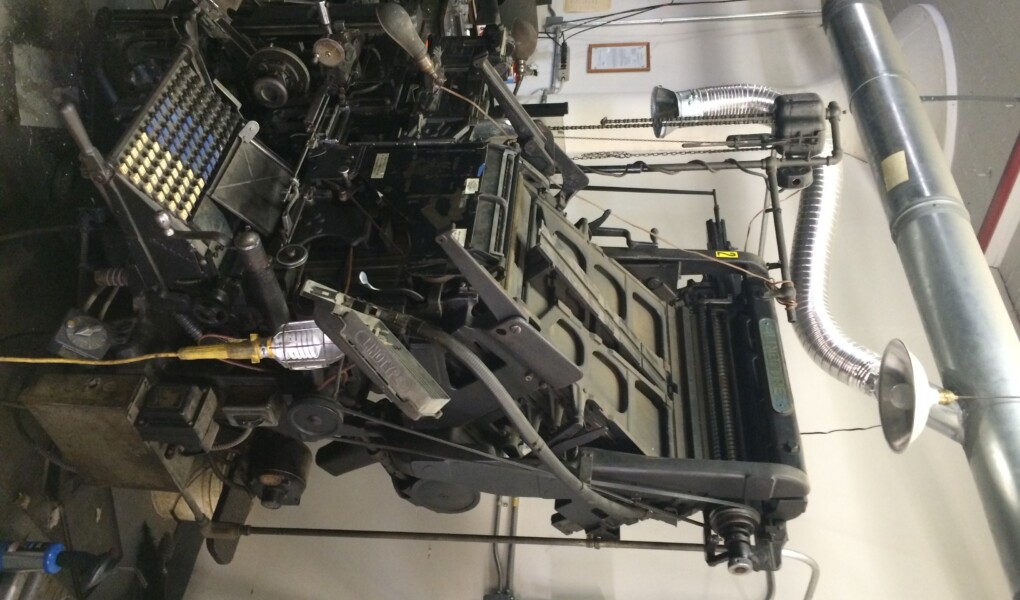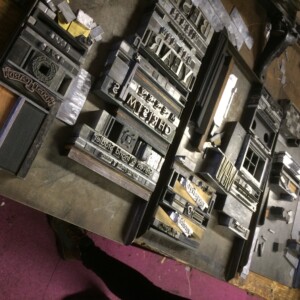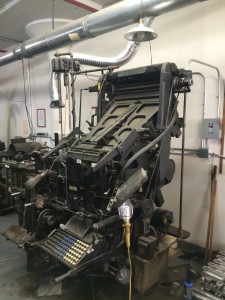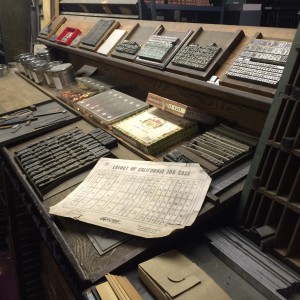Woodside Press is one of our featured Brooklyn Navy Yard tenants on our Making It In NYC: Inside Industry at the Brooklyn Navy Yard tour series. This past winter, we visited the letterpress printshop to learn about their company and the unique services they offer. Woodside was founded back in 1993 by Andy Birsh in Woodside, Queens (hence the name), and in 1998 moved into their space in Building 3 at the Brooklyn Navy Yard. We were shown around the print shop by Davin Kuntze, who has been with the company for more than 10 years.
As a letterpress printer, it can sometimes be a challenge to explain what they do to people who are not versed in the typographical arts. Essentially, Woodside prints things – posters, books, stationary, invitations, etc. – using methods that pre-date the introduction of offset and digital printing. They use a variety of tools and techniques, including handset type and linotype machines (more on those later) to make items for their clients.
Their process can be labor intensive, especially when compared to point-and-click printing on our computers. “Trying to explain to a client why I have to charge them more if they want to see a different typeface when I’ve already set their entire invitation in another typeface is hard,” Davin said.
So what are the advantages of letterpress? One is the unique design that Woodside has at their disposal. We tend to assume that every typeface ever invented must be available pre-loaded in our word processors or for download online, but many failed to make the transition from the physical to the digital world. And many of them, while they may still carry the same name, had their design drastically changed to fit the new format of computer screens and inkjet printers. As a result, a traditional printshop may be the only place to find these rare and unique designs. Another advantage is the tactile qualities – the text has what they call dimensionality, slightly raised or depressed from the paper – that make the finished product so appealing.
These design and aesthetic appeals aren’t just appreciated by the clients, but the practitioners as well. Davin noted, “I like the design restrictions of working with [handset type].” Last year, The Economist wrote about the resurgence in the popularity of letterpress, which they attributed in part to “digital fatigue—a yearning for individualised [sic] products and hands-on experience.”
Davin did point out one big disadvantage, however: “When you’re all done, you have to put it all away,” resorting all the tiny metal cubes back into their drawers.
Woodside’s 5,000 square-foot shop is filled with equipment, much of which has been acquired over the years from print shops and factories that have gone out of business. Part of the genesis for the company was the collapse American Type Founders, based in Elizabeth, NJ, which had been the preeminent manufacturer of typefaces and printing presses in the US. Their bankruptcy prompted a fire sale, at which Andy was able to acquire a number the presses that are still in Woodside’s shop today.
Woodside’s collection of typefaces has come in a similar manner, collected piecemeal from auctions and donations. But this is really the only way to find handset type these days, as there are only a few manufacturers of it left, and they only do limited production runs. Though the collection pales to what you might find in a printshop 150 years ago, with millions of well-organized pieces, Woodside had assembled an impressive catalogue that has few peers in the US.
In addition to handset type, which is “pretty much unchanged for 400 years,” Woodside also has a pair of Linotype machines. A quantum leap in printing technology in the late 19th century (there’s more than one movie about them), these machines eliminated the task of meticulously setting an entire page of type by hand, one letter at a time. Instead, the machine allowed the printer to use a keyboard to mechanically set a mold to cast the letters in molten lead, producing one complete line of text at a time. Also known as “hot type,” this process allowed for a massive increase in printing speed and quantity, catapulting daily newspapers from a few pages (there just wasn’t enough time in a day to handset more) to almost unlimited length.
Woodside not only still uses these machines, they also happen to sit in the shadow of their creation. German immigrant Ottmar Mergenthaler invented the first linotype machine in 1886, and soon the machines of the Mergenthaler Linotype Company were in demand around the world. In 1906, he moved his factory to Brooklyn, eventually occupying two entire blocks between Flushing Ave and Park Ave, right across the street from the Brooklyn Navy Yard. Today, Woodside has a Mergenthaler machine, as well as a machine from the Ludlow Typograph Company.
But Woodside does not eschew modern technology. For graphics and images, which used to require highly-skilled engravers to make printing plates, machines can transfer these digital files to polymer or metal sheets that can then printed in the traditional press (Woodside sends these types of jobs off-site). The result is the best of both worlds – faster, affordable printing, with the tactile advantages of letterpress.
In addition to fulfilling your letterpress printing needs, Woodside is also teaching people the skills of traditional printing. Davin leads regular printing workshops, a three-hour master class in typesetting and poster printing. [UPDATE: Contact Woodside about upcoming events, classes, and tours, as they no longer offer classes through Sidetour.]







